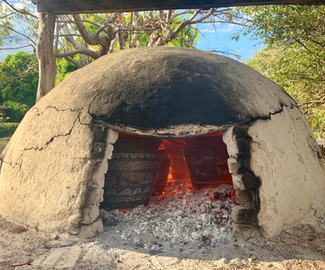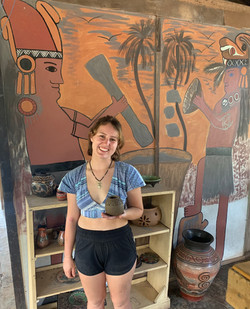ceramics & celebrations
- Cat

- Feb 2, 2023
- 2 min read
I spent one week in the rural town of San Vincente de Guanacaste in the northern province of Costa Rica. The area is known for its ceramic production which dates back 14,000 years ago to the Chorotega indigenous people. Originally, only women made the ceramics (while the men worked the land), however, since the female artisans began earning money from tourism in the 90s, the industry is now split 50-50.
There were many ceramic stalls with at least one family member from each generation working in the trade. I was lucky enough to learn from a few different artisans about the different techniques in ceramic making. I made a mug and an egg basket.
I didn't realise how long the process took to make just one piece...
the height of cups/vases is built up layer by layer
the piece is left to dry
each layer of paint has to be polished
you can etch designs
once dry, it is fired in the outdoor oven (which also gets used for food)
I learnt that the iconic three-legged plates are a traditional design where each leg represents the three ages: stone, ice, and industrial. Since 2012, we have been in the New Age.
Another feature to note are handles on mugs; handles are designed to be used by one person, whereas handle-less mugs are meant to be passed around the family.
I really enjoyed being in the small rural town, however, I could feel all eyes were on me.
There was lots of whistling, instead of yelling, to get people's attention.
I also heard everyone use mae which is the Costa Rican word for 'dude'.
I learnt that pul is short for pulpería which is a minimart and not an octopus shop as I had originally thought (because pulpo means 'octopus').
I had lots of the usual rice and beans, but I also tried a bone broth soup with meat and various vegetables such as cassava, potato, sweet potato, plantain, and cabbage. I also had ice cream out of a bag! It's pretty common to see people selling ice cream and drinks out of plastic bags. You have to bite off the corner then suck it out.
My stay coincided with the annual fair in Santa Cruz which goes for nine days and has visitors from all over the country. There are constant processions through the streets with traditional costumes and music. I loved the colourful skirts (influenced by Spain) worn by the women.
The women of Guanacaste are also known for their high pitched screaming which I was told they do when they are "happy".
Bombas are also an essential part of the culture in Guancaste. They short improvised verses which are often yelled or written down to express the poet's love for life.
We ate a lot of cajeta ('fudge') made specifically for the fair.
I loved listening to the the marimba music. There were many family ensembles and lots of happy dancers.
I also peeked into the bull ring which was quite frightening. Apparently, it is common for people to get injured and even die from bull attacks. Some people consider it brave to be killed or wounded by a bull...

Thank you so much to the people who hosted me and friends I met along the way. I felt very looked after and hope to return.





























Comments